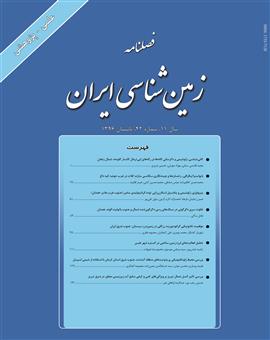بررسی تاثیر گسل شمال تبریز بر ویژگیهای کمی و کیفی منابع آب زیرزمینی مجاور در شرق تبریز
محورهای موضوعی :ابراهیم رجب پور 1 , عبدالرضا واعظی هیر 2
1 -
2 - دانشکاه تبریز
کلید واژه: هیدروژئولوژی زون گسلی آب¬, زیرزمینی گسل شمال تبریز ساختار آبخوان.,
چکیده مقاله :
بر اساس نتایج این مطالعه، گسل شمال تبریز بهعنوان ساختار تکتونیکی برجسته در شمال غرب ایران تاثیر زیادی بر شرایط هیدروژئولوژیک آبخوان محلی منطقه داشته است. بر اساس بررسی های هیدرواستراتیگرافی لاگ چاه های منطقه، از تجمع توف های تراوا، آبخوان غیر محبوسی تشکیل شده و در کل منطقه بهصورت مستقیم بر روی مارن قرمز رنگ میوسن (سنگ کف)، قرار گرفته است. سنگ کف بخش شمالی آبخوان در ترازی بالاتر از سنگ کف بخش جنوبی قرار گرفته و می تواند دلیلی بر وجود حرکت شیبلغز معکوس گسل در این منطقه باشد که در اثر آن، بخش شمالی (فرادیواره) بر روی بخش جنوبی (فرودیواره) لغزیده است. اختلاف تراز سنگ کف در فاصله ای نسبتاً کم (کمتر از 200 متر)، می تواند نشانه ای بر شیب نزدیک به قائم برای گسل باشد. مجموع عمق چاه های بخش جنوبی، چهار برابر بخش شمالی و مجموع آبدهی سالانه چاه های بخش جنوبی در حدود هشت برابر بخش شمالی است. همچنین، اختلاف بین تراز سطح آب زیرزمینی طرفین گسل در برخی مقاطع در فاصله ای حدود 200 متر به بیش از هشت متر بالغ میشود. نتایج ارزیابی تغییرات کلر و EC، نشانه وجود تغییرات شدید کیفی آب زیرزمینی در عرض زون گسلی است. نتایج حاصله می تواند نشانه ای بر رفتار مانع وار گسل در مقابل جریان از عرض آن در این منطقه باشد. بررسي سختی کل و غلظت يون هاي موجود در آب هاي منطقه نشان میدهد كه اكثر نمونه-هاي بخش شمالی جهت مصارف شرب مناسب نمی باشند ولی نمونه های بخش جنوبی جهت شرب مناسب می باشند. درحالیکه تمامی نمونه های بخش شمالی دارای ضریب لانژلیه منفی (خورنده) می باشد. تمامی نمونه های بخش جنوبی دارای ضریب لانژلیه مثبت خیلی نزدیک به صفر بوده و حاکی از متعادل بودن این آب ها می باشد. این امر با واقعیت منطقه نیز تطابق کامل دارد چرا که اکثر صنایع موجود در منطقه در بخش جنوبی گسل متمرکز شده اند.
The North Tabriz Fault (NTF) is the most prominent tectonic structure in the Northwest of Iran. The results of this study show that this fault has a major impact on hydrogeological conditions of the local aquifer. Plio-Quaternary volcanic ash and tuff layers constitute the only unconfined aquifer of this area which directly lies on Miocene red marl as aquifer bed rock. Northern part aquifer bed rock is placed in the higher level than the southern part. This could be the reason for the existence of the reverse dip-slip movement of fault in this area, which causes the northern part (hanging wall) trust over the southern part (footwall). Sharp differences in aquifer bed rock level at relatively low distances (less than 200 m), can be a sign of near-vertical slope of fault in this area. An obvious groundwater level differences which reaches to more than 8 meters, along with the apparent differences between groundwater qualities across the fault at a low distance (about 200 meters) show a barrier behavior of fault. Total depth of the southern part wells is four times compared to the northern parts. Total annual discharge of southern part wells is about eight times of northern parts. Total hardness and ions concentrations of groundwater samples shows that most of the northern part samples are not suitable for drinking purposes, but the southern part samples are suitable. Also, all of the northern part samples have the negative Langelier index (corrosive). All of the southern part samples have the positive (very close to zero) Langelier index and suitable for industrial usages. Therefore this is a reason why most of industries in this area were located in the southern part of the fault.
